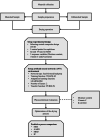Process Optimization of Fluidized Bed Drying for Water Spinach: Evaluating the Effect of Blanching Through RSM and ANN Models
- PMID: 40129994
- PMCID: PMC11931448
- DOI: 10.1002/fsn3.70114
Process Optimization of Fluidized Bed Drying for Water Spinach: Evaluating the Effect of Blanching Through RSM and ANN Models
Abstract
The quality of the dried leafy vegetables, such as water spinach (Ipomoea aquatica), has been found to be significantly affected by the drying process in terms of moisture content and retention of important nutrients, namely vitamin C and β-carotene. There is great potential for fluidized bed drying to be applied for leafy vegetables in optimizing process parameters for maximum nutrient retention since it has not been researched. This work investigated the effect of temperature, drying time, and bed thickness on the nutritional quality of blanched and unblanched water spinach samples. In the present study, the fluidized bed drying process has been designed and optimized using a Central Composite Design (CCD) and Response Surface Methodology (RSM). For this study, both RSM and artificial neural network (ANN) predictive models are developed for further comparison. Using a multiobjective desirability function, the best-optimized response was given from the experimental model for the responses of moisture content, vitamin C, and β-carotene retention. Appropriate statistical metrics are applied, for example, AARD (Absolute Average Relative Deviation), MRD (Mean Relative Deviation), MSE (Mean Squared Error), and R 2 (Coefficient of Determination), which helped in model comparison during the study. It was observed from the experiment that all the response variables are significantly affected by drying temperature, time, and bed thickness. Variation of bed thickness in the blanched samples affected > 16% in moisture content attainment compared to unblanched samples, and vitamin C content exhibited a variation of more than 25% due to changes in bed thickness for blanched samples on the contrary. RSM has shown a better performance than ANN in its precision and prediction power. The optimized drying conditions came out to be 60°C as the drying temperature, 7.19 min as the drying time, and 5.12 cm as the bed thickness, which resulted in 2.95% of moisture content, 5.99 mg/100 g vitamin C, and 139.16 μg/g of β-carotene. The close alignment between predicted and experimental values confirms the suitability of the optimized conditions for industrial-scale drying of leafy vegetables.
Keywords: artificial neural network (ANN); fluidized bed drying; optimization; predictive modeling; response surface methodology (RSM); water spinach.
© 2025 The Author(s). Food Science & Nutrition published by Wiley Periodicals LLC.
Conflict of interest statement
The authors declare no conflicts of interest.
Figures








Similar articles
-
Microwave assisted fluidized bed drying of bitter gourd: Modelling and optimization of process conditions based on bioactive components.Food Chem X. 2023 Jan 9;17:100565. doi: 10.1016/j.fochx.2023.100565. eCollection 2023 Mar 30. Food Chem X. 2023. PMID: 36845471 Free PMC article.
-
Statistical optimization of the phytoremediation of arsenic by Ludwigia octovalvis- in a pilot reed bed using response surface methodology (RSM) versus an artificial neural network (ANN).Int J Phytoremediation. 2018 Jun 7;20(7):721-729. doi: 10.1080/15226514.2017.1413337. Int J Phytoremediation. 2018. PMID: 29723047
-
Modelling and experimental analysis of rice drying in new fluidized bed assisted hybrid infrared-microwave dryer.Food Res Int. 2022 Sep;159:111617. doi: 10.1016/j.foodres.2022.111617. Epub 2022 Jul 5. Food Res Int. 2022. PMID: 35940808
-
Optimization of spray drying process parameters for the food bioactive ingredients.Crit Rev Food Sci Nutr. 2024;64(17):5631-5671. doi: 10.1080/10408398.2022.2156976. Epub 2022 Dec 22. Crit Rev Food Sci Nutr. 2024. PMID: 36547397 Review.
-
Recent application of artificial neural network in microwave drying of foods: a mini-review.J Sci Food Agric. 2022 Nov;102(14):6202-6210. doi: 10.1002/jsfa.12008. Epub 2022 May 28. J Sci Food Agric. 2022. PMID: 35567404 Review.
Cited by
-
Modeling and Optimization of Microwave Vacuum Drying for Pinelliae Rhizoma: Integrating Drying Kinetics, Artificial Neural Networks, and Quality Preservation.Food Sci Nutr. 2025 Aug 15;13(8):e70672. doi: 10.1002/fsn3.70672. eCollection 2025 Aug. Food Sci Nutr. 2025. PMID: 40822519 Free PMC article.
References
-
- Akhtaruzzaman, M. , Mondal M., Biswas M., Sheikh M., Khatun A., and Sarker M. S. H.. 2021. “Evaluation of Drying Performance, Energy Consumption, and Quality of Two‐Stage Dried Maize Grain.” Journal of Biosystems Engineering 46, no. 2: 151–162. 10.1007/s42853-021-00095-w. - DOI
-
- An‐Erl King, V. , Liu C.‐F., and Liu Y.‐J.. 2001. “Chlorophyll Stability in Spinach Dehydrated by Freeze‐Drying and Controlled Low‐Temperature Vacuum Dehydration.” Food Research International 34, no. 2: 167–175. 10.1016/S0963-9969(00)00148-4. - DOI
-
- Asfaram, A. , Ghaedi M., Dashtian K., and Ghezelbash G. R.. 2018. “Preparation and Characterization of Mn0.4Zn0.6Fe2O4 Nanoparticles Supported on Dead Cells of Yarrowia lipolytica as a Novel and Efficient Adsorbent/Biosorbent Composite for the Removal of Azo Food Dyes: Central Composite Design Optimization Study.” ACS Sustainable Chemistry & Engineering 6, no. 4: 4549–4563. 10.1021/acssuschemeng.7b03205. - DOI
-
- Bagherlou, N. , Ghasemi E., Gharbani P., Babazadeh M., and Mehrizad A.. 2024. “Optimization and Modeling of Betamethasone Removal From Aqueous Solutions Using a SiO2/g‐C3N5@NiFe2O4 Nanophotocatalyst by RSM.” npj Clean Water 7, no. 1: 1–10. 10.1038/s41545-023-00295-1. - DOI
-
- Barros, L. , Ferreira M.‐J., Queirós B., Ferreira I. C. F. R., and Baptista P.. 2007. “Total Phenols, Ascorbic Acid, β‐Carotene and Lycopene in Portuguese Wild Edible Mushrooms and Their Antioxidant Activities.” Food Chemistry 103, no. 2: 413–419. 10.1016/j.foodchem.2006.07.038. - DOI
LinkOut - more resources
Full Text Sources

